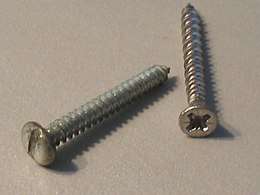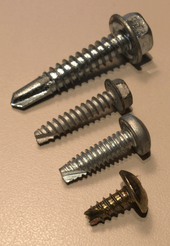Self-tapping screw
A self-tapping screw is a screw that can tap its own hole as it is driven into the material.

Mechanism

Self-tapping screws have a wide range of tip and thread patterns, and are available with almost any possible screw head design. Common features are the screw thread covering the whole length of the screw from tip to head and a pronounced thread hard enough for the intended substrate, often case-hardened.[1]
For hard substrates such as metal or hard plastics, the self-tapping ability is often created by cutting a gap in the continuity of the thread on the screw, generating a flute and cutting edge similar to those on a tap. Thus, whereas a regular machine screw cannot tap its own hole in a metal substrate, a self-tapping one can (within reasonable limits of substrate hardness and depth).
For softer substrates such as wood or soft plastics, the self-tapping ability can come simply from a tip that tapers to a gimlet point (in which no flute is needed). Like the tip of a nail or gimlet, such a point forms the hole by displacement of the surrounding material rather than any chip-forming drilling/cutting/evacuating action.
Not all self-tapping screws have a sharp tip. The type B tip is blunt and intended for use with a pilot hole, often in sheet materials. The lack of a sharp tip is helpful for packaging and handling and in some applications may be helpful for reducing the clearance necessary on the reverse of a fastened panel or for making more thread available on a given length screw.[2]
Thread-forming vs. thread-cutting
Self-tapping screws can be divided into two classes;[3] those that displace material (especially plastic and thin metal sheets) without removing it are termed thread-forming self-tapping screws; self-tappers with sharp cutting surfaces that remove the material as they are inserted are termed thread-cutting.
Thread-forming screws may have a non-circular plan view, such as the five-fold symmetry of the pentalobular or three-fold symmetry for Taptite screws.
Thread-cutting screws have one or more flutes machined into their threads, giving cutting edges.
Self-drilling screw

Some self-tapping screws are also self-drilling, which means that, in addition to the tap-like flute in the leading threads, there is also a preliminary drill-like fluted tip that looks much like the tip of a center drill. These screws combine a thrilling-like action and the fastener installation itself into only one driving motion (instead of separate drilling, tapping, and installing motions); they are thus very efficient in a variety of hard-substrate applications, from assembly lines to roofing.[4][5]
Sheet metal screw
Sheet metal screws (sometimes called "sheet-metal self-tappers", or P-K screws from the brand name Parker Kalon - who pioneered[6] the manufacture of, but did not invent, these screws) are a type of self-tapping screw despite the thread created in the sheet of metal being small. Pan-head PK Self-tapping screws are common in electrical equipment,[7] while flatter-headed truss or flat countersunk headed self-tapping screws[8] are more common in aviation applications.
Winged self-tapper
Winged self-drilling have thin wings wider than the thread formed just behind the self drilling head. These cut a clearance hole in soft materials (such as wood or plastic), but are destroyed by more robust materials (such as metal). Thus, to clamp some material to metal, the clearance drilling, tap drilling, thread tapping, and fixing itself can happen in a single operation from one side, with the materials in their final position.[9]
Applications
Self-tapping screws are used in a variety of applications ranging from DIY carpentry to surgery.
Surgical
Dental implants and orthopedic bone screws are both examples of self-tapping screws used in surgery. Different thread profiles are used for either denser cortical bone or the spongy cancellous bone.[10]
See also
References
- "Fastenerdata". Retrieved 10 November 2017.
- "Self Tapping Screws". Retrieved 9 November 2017.
- Plastics Design Library. Handbook of Plastics Joining: A Practical Guide. Cambridge University Press. p. 107.
- "Self Drilling Screws vs. Self Tapping Screws". Retrieved 9 November 2017.
- "Self-Drilling vs. Self-Tapping Screws". Retrieved 9 November 2017.
- "Modern Plastics Encyclopedia". 33. New York: Breskin & Charlton Publishing Corporation. 1955: 41. Cite journal requires
|journal=(help) - "PK-Self Tapping Screws". Archived from the original on 28 September 2017. Retrieved 14 April 2017.
- "Sheet Metal Screws". Retrieved 14 April 2017.
- "How do I Choose the Correct Self-Drilling and Self-Tapping Screws??". Retrieved 9 November 2017.
- Maurice E. Müller; Martin Allgöwer. Manual of INTERNAL FIXATION: Techniques Recommended by the Ao-Asif Group. Springer Science & Business Media. p. 108.
External links
| Wikimedia Commons has media related to Self-tapping screws. |
- "Hold Everything", February 1946, Popular Science bottom of page 151